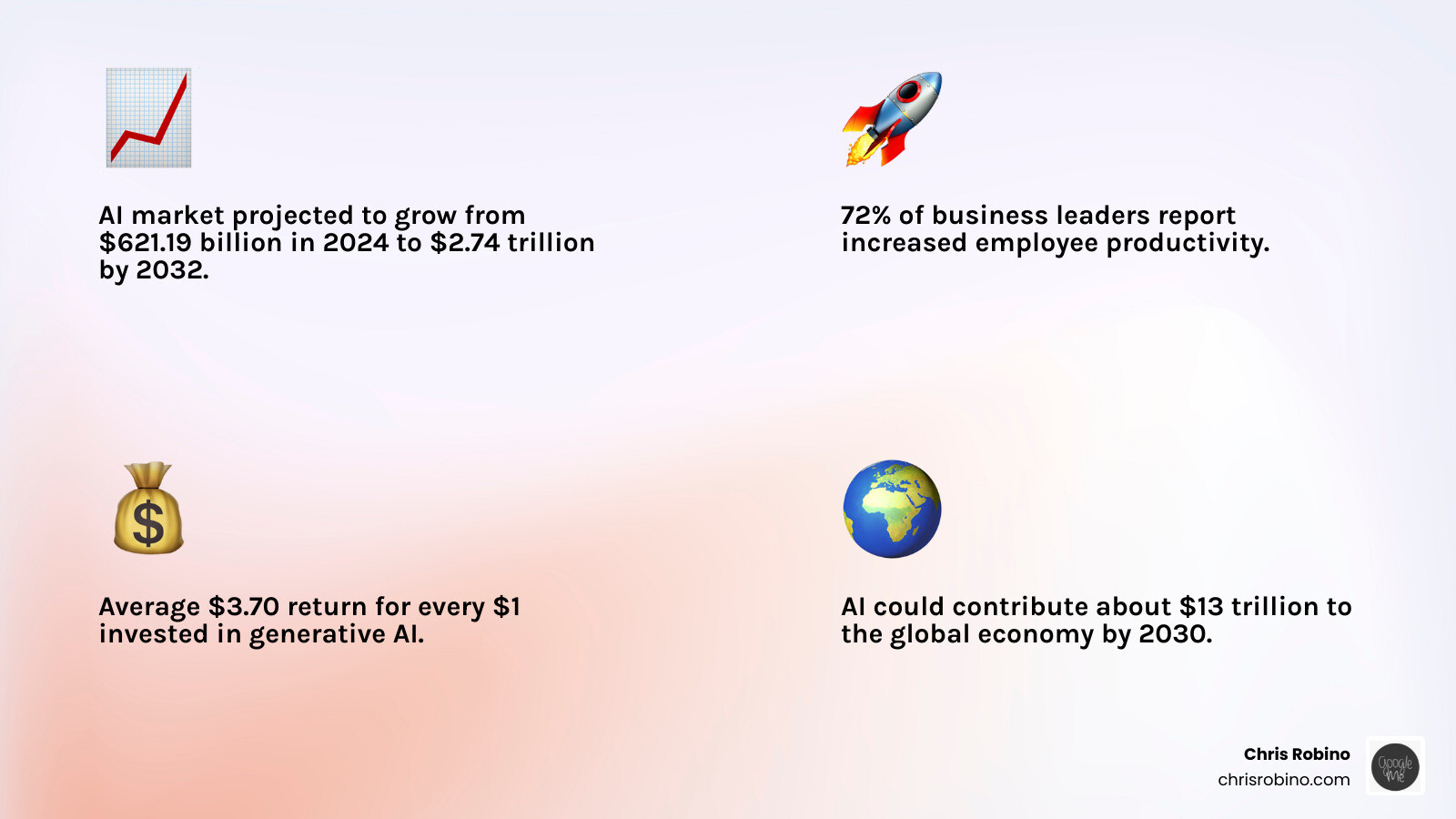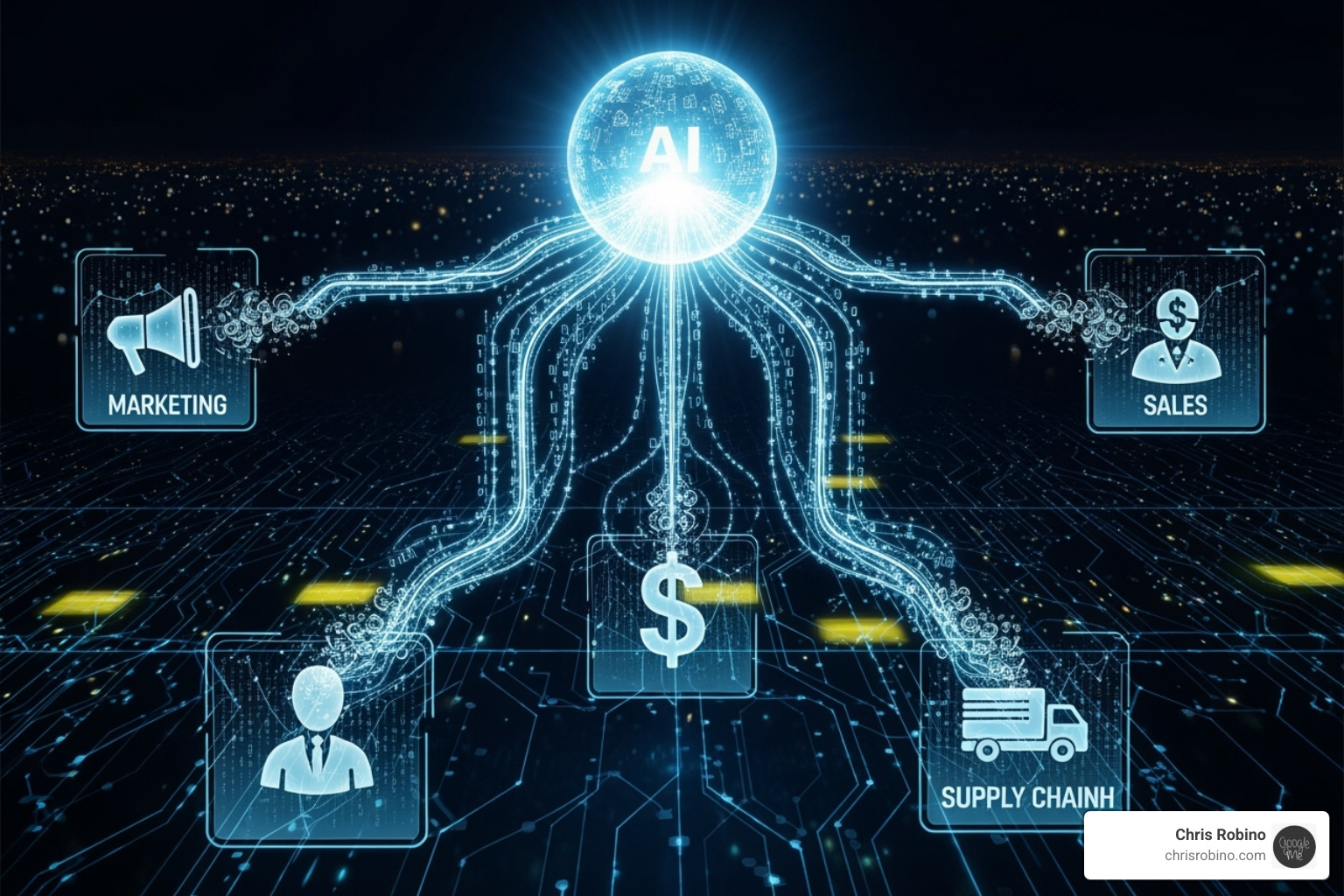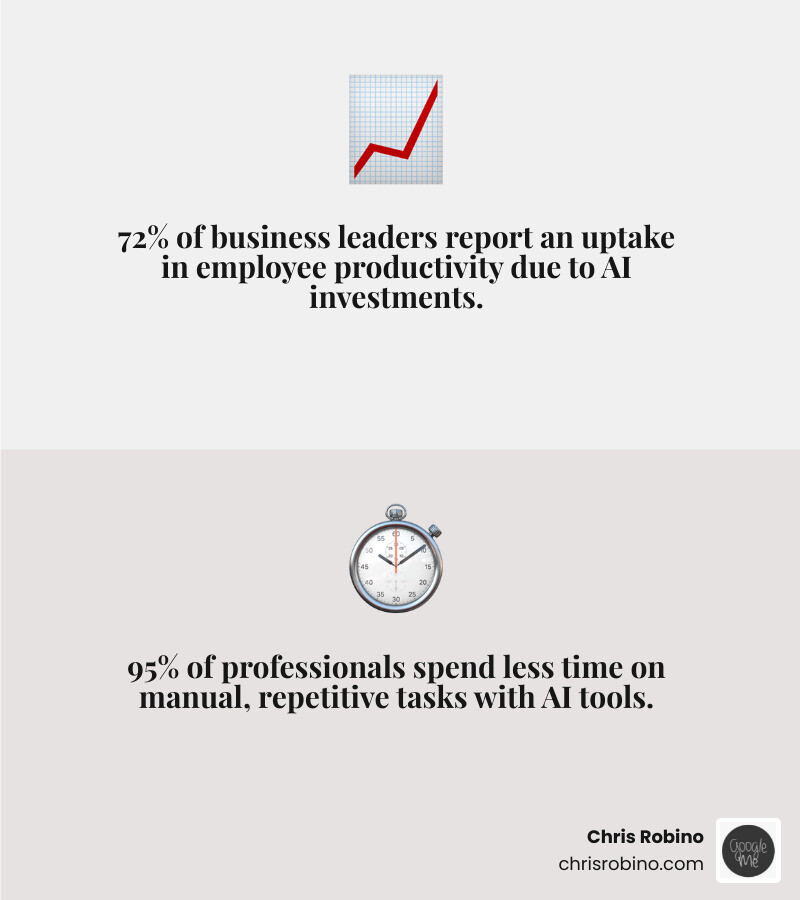Why AI Driven Business Solutions Are Reshaping Modern Commerce
AI driven business solutions are fundamentally changing how companies operate. From automating customer service and personalizing marketing to optimizing supply chains with predictive analytics, AI is the new engine of growth. The benefits are clear: 72% of business leaders see higher productivity, generative AI yields an average $3.70 ROI for every dollar spent, and 95% of professionals spend less time on repetitive tasks.
The economic impact is staggering. AI is projected to contribute $13 trillion to the global economy by 2030, with its market size soaring to $2.74 trillion by 2032. This isn’t a future trend; it’s a present-day reality. Leading companies save hundreds of thousands of hours of manual work annually with AI, with some cutting over 50,000 hours from their recruitment process alone. As Harvard Business School Professor Karim Lakhani notes, the “AI factory” is built on predictions, pattern recognition, and process automation—the new backbone of business.
I’m Chris Robino, and for over two decades, I’ve helped organizations steer digital change and implement AI driven business solutions for measurable growth. My work focuses on integrating AI systems that deliver real ROI and a sustainable competitive edge.

What Makes a Business Truly AI-Driven?
AI driven business solutions are more than just tech add-ons; they represent a fundamental rethinking of how companies create value. For decades, businesses relied on gut instinct and historical data—like navigating modern traffic with a paper map. It worked, but it missed the real-time picture.
AI-driven business models flip this script. Instead of reacting to the past, they anticipate the future. Every customer interaction and internal process becomes a learning opportunity, making the entire organization smarter. As Professor Marco Iansiti of Harvard Business School puts it, *”It’s a fundamentally new kind of organization.”
Think of a traditional retailer versus a leading e-commerce giant. The former uses yesterday’s sales to stock tomorrow’s shelves. The latter’s AI analyzes millions of real-time data points to predict what you’ll want before you even know it.
| Aspect | Traditional Business Model | AI-Driven Business Model |
|---|---|---|
| Data Usage | Primarily historical, siloed, manual analysis | Real-time, integrated, continuous, automated analysis |
| Decision Making | Human-centric, intuition, experience, reactive | Data-driven, predictive, prescriptive, proactive, automated |
| Value Proposition | Product/service delivery, human labor-intensive | Data insights, personalized experiences, automated efficiency |
| Scalability | Linear, constrained by human resources and infrastructure | Exponential, driven by algorithms and automation |
The Core Characteristics of an AI-First Company
What separates true AI-first companies from those just dabbling? Four key characteristics.
Datafication is the foundation. Every click, process step, and interaction is transformed into structured data. For example, smart thermostats learn your routines and factor in weather to optimize energy use, saving homeowners about 8% on heating and cooling costs.
Algorithmic optimization turns that data into smart decisions. As Karim Lakhani says, “The data by itself doesn’t do anything.” The best algorithms continuously learn and adapt, getting smarter with every interaction.
Intelligent automation puts this into practice, automating not just simple tasks but complex decision-making. This frees your team to focus on strategy, creativity, and innovation.
Network effects create a virtuous cycle: more users generate more data, which makes the system smarter, which attracts more users. It’s a powerful advantage that traditional businesses struggle to match.
From Manual to Automated: The Operational Shift
The journey to becoming AI-driven often starts by asking, “What can a computer do better, faster, or more accurately?”
Robotic Process Automation (RPA) is often the first step, handling tedious tasks like data entry and invoice processing. One major financial institution saved 360,000 hours of manual work annually by automating contract interpretation. That’s equivalent to giving 180 employees their entire year back for more meaningful work.
The real power emerges when AI optimizes complex systems. A major e-commerce company’s AI-powered packaging system chooses the perfect box size for every order by analyzing millions of variables, improving efficiency and sustainability at a massive scale. This operational shift frees up human capital for what people do best: strategy, innovation, and building relationships. Well-implemented AI doesn’t replace humans; it amplifies their capabilities.
Key AI Driven Business Solutions by Department
AI driven business solutions are changing every department, creating new opportunities across the entire organizational landscape.

AI in Marketing and Sales
In marketing and sales, AI enables hyper-personalization and unprecedented efficiency. By analyzing customer data, AI delivers the right message to the right person at the right time, boosting engagement.
Predictive analytics is crucial for lead scoring, helping sales teams prioritize prospects most likely to convert. For instance, advanced AI can analyze market competition and accelerate audience segmentation up to 90% faster.
AI also revolutionizes content creation. Nearly 90% of marketers report AI improves content quality. In sales, generative AI is effective for crafting prospecting messages (86% of pros agree) and building rapport faster (72% agree). Advanced AI tools can complete daily sales tasks 80% faster, freeing teams to focus on relationships.
SEO Strategies That Perform Well for Large Companies
For large enterprises, AI is essential for sophisticated, data-driven SEO.
- Leveraging AI for large-scale keyword research and clustering: AI tools process immense datasets to identify high-value keywords and group them by search intent for targeted content strategies.
- Automating technical SEO audits and site health monitoring: AI can continuously crawl large websites to identify and flag technical issues like broken links or slow page speeds in real-time.
- Personalizing content at scale using AI-driven insights: AI can tailor content recommendations based on individual user behavior, improving engagement and signaling relevance to search engines.
- Optimizing internal linking structures with AI recommendations: AI analyzes content relationships to suggest optimal internal linking strategies, improving site architecture and crawlability.
- Using AI to analyze content gaps: AI can analyze the digital landscape and industry content to pinpoint areas where your content is lacking, enabling a strategic approach to content creation.
- Implementing AI-powered A/B testing for landing pages and CTAs: AI rapidly tests multiple variations of pages and calls-to-action to identify the most effective designs for different audience segments.
- Integrating AI with analytics to measure and refine SEO ROI: AI can connect SEO performance directly to business outcomes like sales, providing a clear picture of ROI for strategy refinement.
- Custom AI solutions for multilingual and international SEO: AI can automate translation, localize content, and optimize for regional search engines, ensuring a consistent global SEO presence.
- Utilizing AI to monitor brand reputation and sentiment across channels: AI-powered tools track brand mentions, allowing for rapid response to feedback and proactive reputation management.
AI in Customer Service
Customer service is on the front lines of AI change.
AI-powered chatbots and virtual assistants provide instant, 24/7 support, improving satisfaction and reducing agent workload. One mid-sized e-commerce company saw a 30% rise in customer satisfaction and a 25% cost reduction after implementing an AI chatbot. Furthermore, 84% of service professionals find AI makes responding to tickets easier. Advanced AI assistants can even provide response suggestions in just 1.5 seconds, saving millions for large companies.
AI in Human Resources
HR is becoming more efficient and equitable with AI. It excels at automated candidate screening, sifting through thousands of resumes to find top candidates. One global consumer goods company saved over 50,000 hours in interview time and $1 million annually using AI for recruitment. AI also helps reduce recruitment time, predict employee attrition, and eliminate bias in communications, promoting diversity. AI platforms can speed up HR tasks like staffing and payroll by 90%, allowing HR to focus on strategic workforce development.
AI in Operations and Supply Chain
For businesses with physical goods and complex logistics, AI drives massive efficiency gains. Predictive maintenance anticipates equipment failures, preventing costly downtime. In supply chain optimization, AI analyzes data to find the most efficient routes and manage inventory. AI-powered systems can cut inbound delivery costs by 50% and inspection costs by 25%. In agriculture, AI helps reduce herbicide use by up to 90%, while in real estate, it automates complex document processing, cutting time by 96%.
The Tangible Benefits of Integrating AI
When businesses adopt AI driven business solutions, they capture real, measurable benefits that impact both daily operations and the bottom line.
Boosting Efficiency and Productivity
The most immediate impact of AI is a dramatic boost in what teams can accomplish. By automating repetitive tasks like data entry and invoice processing, employees are free to focus on creative problem-solving and strategy.
The results are impressive: 72% of business leaders report increased employee productivity, and 95% of professionals say AI frees them from manual tasks. This gives nearly 90% of workers more time for high-value activities.
Faster data analysis and streamlined workflows create a ripple effect of efficiency. For example, AI-powered systems can reduce inbound delivery costs by 50% and inspection costs by 25%. AI also accelerates internal processes like payroll and onboarding by up to 90%, allowing new hires to become productive sooner and reducing administrative burdens on existing staff.

Sharpening Strategy with Data-Driven Insights
Beyond operational efficiency, AI driven business solutions transform strategic decision-making. Leaders can move beyond gut feelings to choices based on comprehensive, real-time analysis.
Real-time decision support allows businesses to react to market changes instantly. Predictive analytics for market trends helps companies see around corners, anticipating customer needs and spotting supply chain disruptions before they occur. This provides a significant advantage, allowing businesses to analyze market competition 90% faster than manual methods.
AI also enables scenario planning and simulation, letting leaders test strategies in virtual environments to reduce risk. Perhaps most importantly, AI provides a granular understanding of consumer behavior, revealing patterns that drive more effective marketing, better products, and stronger customer relationships. The result is a strategy that is both bolder and smarter.
Navigating the Challenges and Ethics of AI
Adopting AI driven business solutions isn’t without challenges. Smart leaders know that rushing into AI without understanding the pitfalls is a mistake. The good news is that these challenges are manageable with a thoughtful approach.
Addressing Ethical Considerations and Bias
Algorithmic bias is a human problem reflected in technology. AI learns from the data it’s given, and if that data contains historical biases, the AI will perpetuate them. For example, a recruitment tool trained on biased hiring data might unfairly penalize certain candidates. The solution involves using bias-mitigation tools and training models on diverse, representative data sets.
Data privacy concerns are also critical. AI is data-hungry, but businesses must handle sensitive information responsibly, adhering to regulations and adopting a privacy-first design. This includes secure data processing to protect against breaches and maintain customer trust.
Finally, the “black box” problem—where AI decisions are opaque—requires a commitment to transparency. Developing Explainable AI (XAI) is key. As industry experts note, trust in AI is built on safety, control, and a governance approach rooted in ethical principles, not just flashy models.
Managing Workforce Change
AI automation will change jobs, but it’s important to understand how. AI typically automates tasks, not entire roles. Just as calculators didn’t eliminate accountants but shifted their focus to analysis, AI will evolve many professions.
The smart approach is proactive management. Forward-thinking businesses invest in reskilling and upskilling programs to prepare employees for human-AI collaboration. This model lets AI handle routine tasks while humans focus on creative problem-solving, strategic thinking, and interpersonal skills.
The goal is to shift employees toward more creative and strategic roles that leverage uniquely human capabilities. This requires fostering an AI-ready culture where continuous learning is encouraged and employees see AI as a tool that augments their abilities. For more on this, explore research on the future of jobs with AI. Companies that manage this transition well communicate openly and invest in their people, making work more meaningful for everyone.
Preparing for the Future: Careers and Strategies for the AI Era
The AI revolution is here, and preparing for it is essential for both individual careers and organizational survival. Encouragingly, AI is creating more opportunities than it’s eliminating, with the U.S. Bureau of Labor Statistics projecting about 356,700 new IT jobs annually from 2023 to 2033. These roles require a blend of technical expertise and business acumen.
Emerging Career Opportunities in AI for Business
The most valuable professionals in the AI driven business solutions space are those who bridge technology and real-world business challenges. Here are some in-demand roles and their average annual salaries:
- AI Engineer: $204,274/year
- Data Scientist: $163,215/year
- Machine Learning Engineer: $157,969/year
- AI Product Manager: $251,095/year
- Business Intelligence Analyst: $135,369/year
- Natural Language Processing (NLP) Specialist: $119,103/year
- Ethical AI Specialist: $137,000/year
- Robotics Engineer: $151,861/year
- AI Research Scientist: $173,998/year
- AI Trainer: $94,974/year
What’s fascinating about these roles is their diversity. An AI Product Manager, the highest-paying role, translates business needs into AI solutions. An Ethical AI Specialist combines philosophy with programming. These are human-centric jobs powered by technology.
How to Prepare Your Organization for AI Integration
For organizations ready to adopt AI driven business solutions, success hinges on building a solid foundation.
Start with your data strategy. High-quality, accessible, and well-governed data is the fuel for AI. Establish reliable data pipelines and governance policies.
Invest in your people. Hire AI specialists and upskill your existing teams. Foster AI literacy across all departments so everyone understands how AI can improve their work.
Create an AI-ready culture. Encourage experimentation, cross-functional collaboration, and learning from failures. Break down departmental silos to accelerate innovation.
Begin with small, high-impact pilot projects. Choose initiatives with clear ROI to build internal confidence and momentum before tackling larger changes.
Secure executive buy-in and vision. AI adoption requires leadership from the top to champion the vision, allocate resources, and communicate its strategic importance.
To help guide your journey, preparing for the next step requires a clear strategy for digital change. The organizations that thrive will be those that thoughtfully integrate AI into their culture, processes, and strategic thinking.
Conclusion
The journey through AI driven business solutions reveals a landscape of immediate, actionable opportunity. This isn’t a distant fantasy; it’s happening now. Companies are saving hundreds of thousands of work hours, boosting productivity by 72%, and seeing returns of $3.70 for every dollar invested in AI.
This change touches every corner of business, from marketing and sales to customer service and supply chain management. Teams are working with greater precision and providing better experiences because their actions are informed by intelligent insights.
The real challenge—and opportunity—is no longer the technology itself, but its strategic and ethical implementation. Smart businesses are asking how to ensure fairness, help teams grow with new tools, and balance AI’s efficiency with the human touch customers value.
The future isn’t about human vs. machine; it’s about combining them to make both more powerful. It’s about building businesses that are more efficient, innovative, and responsive.
If you’re looking for expert guidance on integrating emerging tech and using the power of AI driven business solutions, I can help. With over two decades of experience in digital change, I understand that successful AI implementation is about building solutions that work for your people and your customers.

